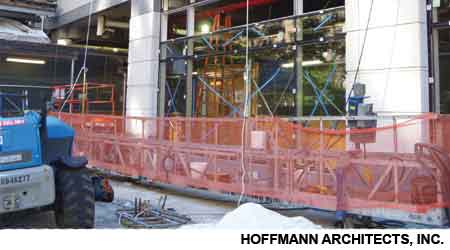Knowing When Window Replacement Is Inevitable
Last of a 4-part article on reaping the energy and cost benefits of window replacement
At some point, windows reach the end of their useful life. The question is, how does a building owner know whether it is advisable to defer a window project another year or two, or to call in a design professional right away? At what point is window replacement inevitable?
The first thing to consider is the comfort of building occupants. Most complaints about office environments involve thermal comfort, often originating at deteriorated windows. Leaks at window openings are obvious indicators of compromised performance, but more subtle problems may also become troublesome, such as difficult operation or drafts. To keep occupants comfortable, a certain amount of energy must be added to or removed from the building interior by the heating and air-conditioning systems. This thermal load can become much higher in buildings with inefficient windows, as HVAC systems run overtime to meet the demand of excess heat transfer through the fenestration.
The cycling of temperatures from one day or season to the next can manifest at windows in the form of shrunken gaskets and seals; warped, faded, or displaced frames; and etched or fogged glass. As windows become scratched, distorted, or clouded, building occupants may complain of compromised views, along with bothersome glare that can impact daylighting availability.
Another factor to consider is maintenance and cost control. As windows age, it may become increasingly difficult and cost-prohibitive to find replacement parts. Keeping up with the needs of older windows is more demanding, as maintenance personnel spend hours responding to user complaints. Protecting building infrastructure from environmental infiltration and chasing after damage can become a strain, and the cost of ongoing problems begins to add up.
As with any capital improvement, aesthetics is also a driving force. New windows can add equity to a commercial property, and present an opportunity to dramatically improve a building’s appearance.
Energy savings alone will not pay for the cost of a typical window replacement project in a reasonable amount of time. However, ancillary factors make energy efficiency an important part of such projects.
Tips on Quantifying Window Assembly Performance
Window assembly performance should be assessed for structural integrity, air and water infiltration, and potential condensation issues, as well as for energy efficiency. Often, much of this quantifying information is available from the manufacturer. Before relying on published material, however, confirm that the data provided pertains to the exact assembly under consideration, and that the test specimen incorporated the same glass that would be installed in the project.
Sometimes, conditions are project-specific and cannot be anticipated in testing performed by the manufacturer. For instance, potential condensation issues that might result from the installation of a replacement window in an existing opening may need to be evaluated through thermal modeling, using software programs such as THERM. Developed by Lawrence Berkley National Laboratory, THERM allows design professionals to model two-dimensional heat-transfer effects in building components and evaluate an assembly’s energy efficiency. Although limited in its ability to assess complex real-world conditions, such as thermal massing, THERM and other computer models can help anticipate problems with thermal bridging, condensation, moisture damage, and structural integrity.
If the variables are too numerous, or there is a need to quantify performance within extremely specific parameters, physical testing of a window assembly and, ideally, of a sample of the wall into which it will be installed, can be performed in lieu of computer modeling. For energy performance, tests are typically performed at a testing facility using a hot box, an apparatus that aims to replicate conditions typical of what is seen in the field. The ASTM International Standard C1363-11, “Standard Test Method for Thermal Performance of Building Materials and Envelope Assemblies by Means of a Hot Box Apparatus,” is the recognized reference standard for such tests.
During installation, windows should be tested for water penetration, as per ASTM Standard E1105, “Standard Test Method for Field Determination of Water Penetration of Installed Exterior Windows, Skylights, Doors, and Curtain Walls, by Uniform or Cyclic Static Air Pressure Difference.” By establishing a pressure differential across the building envelope, this test method encourages water from a calibrated spray grid at the exterior to migrate into the building. Window assemblies and the surrounding substrate can then be evaluated for watertightness.
Related Topics:











